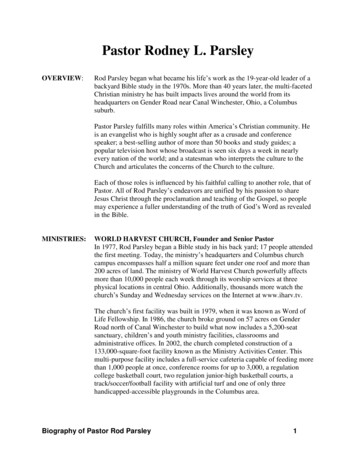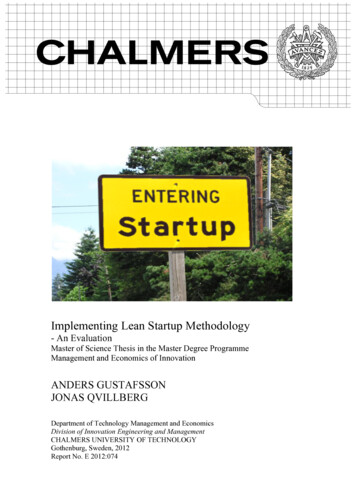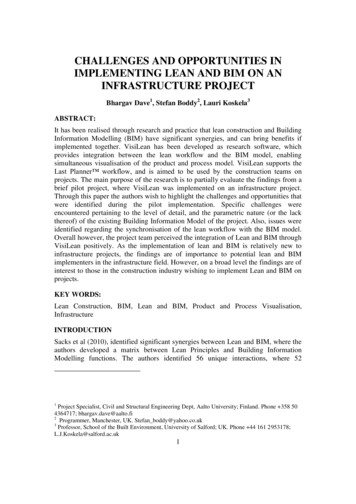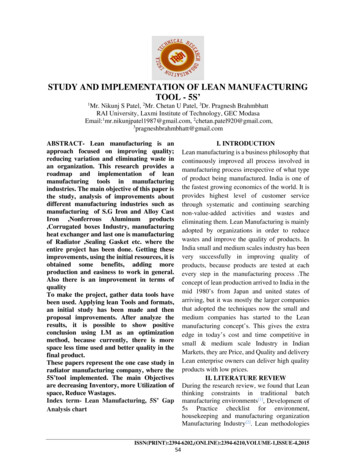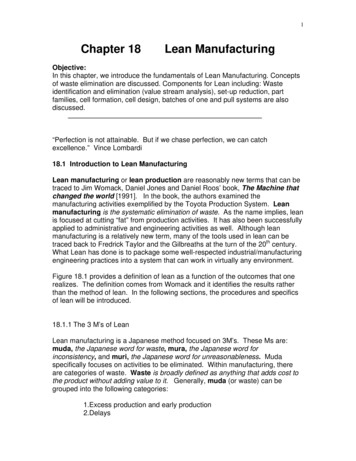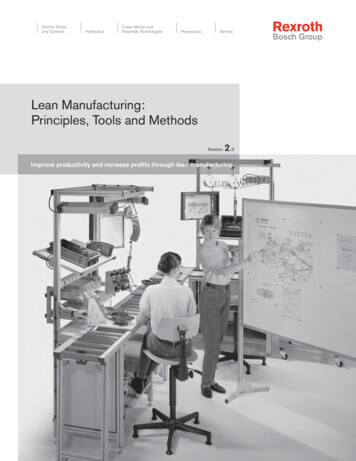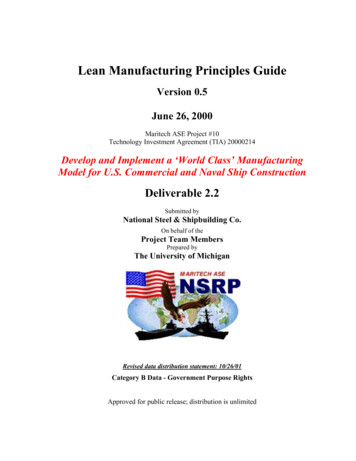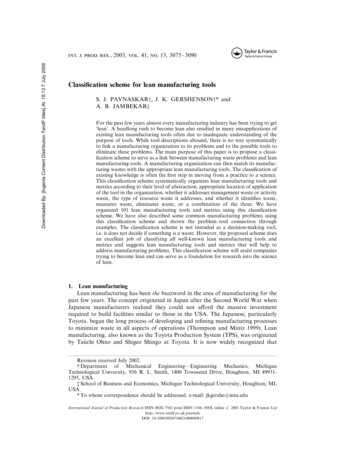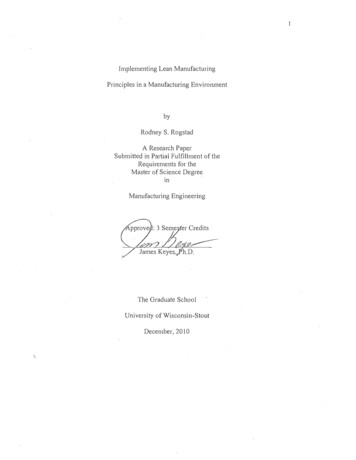
Transcription
Implementing Lean ManufacturingPrinciples in a Manufacturing EnvironmentbyRodney S. RogstadA Research PaperSubmitted in Pmiial Fulfillment of theRequirements for theMaster of Science DegreeInManufacturing EngineeringJames Keyes,jh.D.The Graduate SchoolUniversity of Wisconsin-StoutDecember, 2010,\
Implementing Lean ManufacturingPrinciples in a Manufacturing EnvironmentbyRodney S. RogstadA Research PaperSubmitted in Partial Fulfillment of theRequirements for theMaster of Science DegreeinManufacturing EngineeringThe Graduate SchoolUniversity of Wisconsin-StoutDecember, 2010
2The Graduate SchoolUniversity of Wisconsin-StoutMenomonie, WIAuthor:Rogstad, Rodney S.Title:Implementing Lean Manufacturing Prillciples in a ManufacturingEnvironmentGraduate Degreel Major: MS Manufacturing EngineeringResearch Adviser:James Keyes, Ph.D.MonthlYear:December, 2010Number of Pages:53Style Manual Used: American Psychological Association, 6 th editionABSTRACTWith the importance of being competitive in today's medical market, Company Xwas focusing their efforts towards lean manufacturing. With the mindset of buildingproducts cheaper, faster, and better to gain a competitive edge in the market, leanmanufacturing helped Company X get there. This paper covers some of the leanprinciples that Company X used to give them the competitive advantage by using valuestream maps, time studies, and spaghetti diagrams. Using these tools gave this company agood understanding of how product flows through their facility, where the value is, andthe lead times associated with building the product. Having a good understanding of theselean tools allowed for a better understanding of the waste that was in the production lineand the importance of eliminating it.
3The Graduate SchoolUniversity of Wisconsin StoutMenomonie, WIAcknowledgmentsFirst and foremost I would like to thank my wife Dana for her patience as I spent many latenights and long weekends over the last 2 1'2 years working towards the completion of my degree,I can't put into words how much I appreciate your support! Next I would like to thank ProfessorKeyes for not only his support and input during the writing of this paper but also for the classesthat he taught The amount that I have learned about Lean is incredible and I can't thank youenough for the knowledge that you have provided, To UW-Stout; thank you for offering the greatprogram of Master of Science in Manufacturing Engineering, Last but not least I want to thankmy entire family for their support". J love you all!
4T ABLE OF CONTENTS. PageABSTRACT . 2List of Tables . 7List of Figures . 8Chapter I: Introduction . 9Statement ofthe.Problem . 10Purpose of the Study . 10Assumptions of the Study . 10Definition of Terms . 10Limitations of Study . 11Methodology . 11Summary . 12Chapter II: Literature Review . 13Introduction . 13Origins of mass production and the birth oflean . 13What is lean manufacturing . 14The seven types of waste in a manufacturing process . 16Steps to eliminate waste in a manufacturing process '" . 18What is lean six sigma . 21Lean six sigma process tools . 22Summary . 24
5Chapter III: Methodology . 26CUITent Assembly Process . 26Instrumentation . 26Data Collection Procedures . 30Data Analysis . 30Limitations . 31Summary . 31Chapter IV: Results . 32Final Assembly Findings . 32Close-Up Findings . 36Summary . 37Chapter V: Discussion . 39Limitations . 39Conclusions . 40Recommendations . 41References . 43Appendix A: Assembly Station 1 and 2 Waste Analysis . 45Appendix B: Assembly Station 3 Waste Analysis . 46Appendix C: Final Assembly Time Reduction . 47Appendix D: Future State Value Stream Map . 48Appendix E: Final Assembly Line Before and After . 49Appendix F: Close-Up Current State Value Stream Map . 50Appendix G: Close-Up Time Savings . 51
6Appendix H: Old Work StationClose-Up . 52Appendix I: New Work StationsClose-Up . 53
7List of TablesTable 1: Definitions for the seven types of waste in a manufacturing process . 17Table 2: Definitions of 5S . ;23Table 3: Definitions of the DMAIC Process . 23
8List of FiguresFigure 1: Assembly station 1 time study . '" . 27Figure 2: Example of spaghetti diagram . 28Figure 3: Example of value stream map . , . 29Figure 4: Assembly line through close-up spaghetti diagram - before . 33Figure 5: Assembly line current state value stream map . 34Figure 6: Assembly line through close-up spaghetti diagramafter . 35
9Chapter I: IntroductionThis project was completed at Company X in a western suburb of the Twin Cities inMinnesota. The current product is a medical device that is approximately nine years old and hasbeen manufactured using the same production techniques for the life of the product. Company Xwanted to change the way the product was produced and flowed through the factory so theCompany could become lean within their manufacturing environment. Company X wasexperiencing large amounts of work-in-process from the final assembly line to the close-up area.The final assembly line consists of three assembly stations. Each station is responsible forassembling specific components into the front housing of the device prior to forwarding to thenext assembly station. The close-up station consists of one work station that is responsible forclosing the front housing to the back housing prior to forwarding to the next station.By recognizing the benefits of lean manufacturing using a pull system as opposed to apush system, Company X made the decision to implement the techniques conducive to one piecef10w by implementing lean principles and promoting a pull system. By taking one area andimplementing lean principles allowed the company to make the successful transition to leanmanufacturing per assembly area rather than try and implement lean into the entire productionfloor all at once. This project focused on final assembly line through close-up. This particulararea was chosen for this project due to excess work-in-process.To gain a better understanding between one piece flow and batch manufacturing, onepiece flow is the process of moving one work-piece at a time between operations. Batchprocessing is producing lots or quantities of parts at one operation and them moving the productto the next operation. Batch manufacturing has the appearance of a disorganized production lineand creates excessive rework of product if an error was discovered down the line. By
10implementing one-piece flow, Company X was able to have an organized assembly line, reducerework, and significantly reduce work-in-process.Statement of the ProblemBatch processing results in more units being worked on than is necessary and producesexcess work-in-process. To reduce work-in-process, Company X wanted to move from batchprocessing to one-piece flow utilizing lean manufacturing principles.Purpose of the StudyThis study analyzed the existing state of manufacturing and testing the medical devices inbatches. An implementation plan was developed to implement lean manufacturing principles tosupport one-piece flow. The plan was implemented and the results of the implementationresulted in improved productivity and resulted in a reduction in work-in-process.Assumptions of the StudyThe assumptions of this study are:1. The work performed by the operators was performed using the detailedmanufacturing procedures in which they are required to be trained to.2. The operators understood and followed the training provided for one piece flow.3. The reduction in work-in-process was the result of implementing one piece flow.4. The improved throughput is the result of implementing one piece flow.5. No significant changes were made to the product that impacted one piece flow.Definition of TermsBatch Processing. Manufacturing process in which components or goods are producedin groups (batches) and not in a continuous stream. (BusinessDictionary.com, n.d.)DMAIC. Define, Measure, Analyze, Improve, Control. (George, 2002)
11IPK. In-process kanbanDetermines the amount ofWIP (Work In Process) that can bekept between any two operations in a process. (Chapados & Perlinska, n.d.)Kanban. Kanban is Japanese for sign or designated place. It is used in manufacturing tomean a visual signal that tells when it is time to get or make more of something. (Chapados &Perlinska, n.d.)Kaizen. Kaizen means "continuous improvement" in Japanese. (George, 2002)One piece flow. This concept starts at the customer, whereby the customer purchases asingle piece and the manufacturing system should replenish only that piece. Hence, the Leansystem stives tomake one piece at a time, this is true one piece flow. (Wilson, 2010)WIP. Work in Process. All materials in the production process once they are withdrawnfrom the storehouse until they are stored as finished goods. (Wilson, 2010)Limitations of the StudyThe limitations of the study are:1. The results of this study are limited from final assembly through close-up.2. The study does not include all lean manufacturing principles.3. The study is intended to show the results of implementing lean manufacturingprinciples.4. This study is specific to Company X.MethodologyA literature review was used to review the principles of lean manufacturing. An implementationplan was developed to implement lean manufacturing principles within the assembly throughclose-up area. A floor layout plan was designed to show the future state of the assembly line.Operators were used to assist in making the improvements to the assembly line and implement
12these principles. Before and after illustrations were used to show the impact of implementing thelean principles. Data was collected and presented in this research to show the improvements inthroughput and the financial impact to reduction in work-in-process.SummaryThis chapter provides an introduction to Company X and the market in which they servealong with the manufacturing issues that were addressed to help better position them to be morecompetitive in the medial market. This chapter also lays the foundation for which the rest of thisstudy provided by helping Company X achieve their goal of using lean manufacturing principlesin their production process.
13Chapter II: Literature ReviewIntroductionThe purpose of this literary review is to gain insight into lean manufacturing and how itcan be applied within a manufacturing environment. With global competition, it is important formanufacturers to remain competitive in their respective markets and to understand the principlesof lean manufacturing and the steps to implement them to ensure that they are on the leadingedge of manufacturing. This literary review describes these key principles.Origins of mass production and the birth of lean.Fred Winslow Taylor, a foundry manager from Philadelphia, laid the foundation for massproduction (Dennis, 2002). He was the first to systematically apply scientific principles tomanufacturing. His many innovations included: Standardized workeasiest way to do the job; Reduced cycle timeidentifying the best andthe time it takes for a given process; Time andmotion study - a tool for developing standardized work; Measurement and analysis tocontinually improve the process. The key to mass production was not the assembly line (Dennis,2002). Rather, it was the thorough interchangeability of parts and ease of assembly. Theseinnovations, in turn, made the assembly line possible.Hemy Fords' conveyor system at the Ford plant, allowed for mass production (Tapping,2007). The moving assembly line brought the car past the stationary worker. (Dennis, 2002) Theassembly line reduced walk time, and most importantly, linked sequential processes. Thus,slower workers sped up and faster workers slowed down. No other company had this technologyand could not compete with the Ford plant (Tapping, 2007).company to industry leadership (Dennis, 2002).Ford's system catapulted the
14In the spring of 1950, a young Japanese engineer named Eiji Toyoda visited Ford's vastRogue Plant in Detroit (Dennis, 2002). He studied every corner of the Rogue, the world's biggestand most efficient manufacturing complex. Upon his return to Japan, Eiji and his productiongenius, Taiichi Ohno, concluded that mass production would not work in Japan. Taiichi Ohnoalready knew that workers were his most valuable resource. In the years to come, Ohno and histeam developed activities to fully involve team members in improvementan utterly novel idea.The Toyota Production System, or lean production, was the solution to Toyota'sproblems (Dennis, 2007). Over the next thirty years, Taiichi Ohno solved these problems one byone and pushed his system through Toyota. Today, the Toyota Production System (TPS) is usedsynonymously with "lean manufacturing" throughout the world (Tapping, 2007). But today weface the same daunting problems that Toyota faced a half century ago, Ohno's system is morerelevant than ever (Dennis, 2007),What is lean manufacturing?Lean manufacturing can best be described as eliminating waste in a production process(Womak and Jones, 1996), Anything that does not add value to the end product is waste, Womakand Jones (1996) stated that lean thinking can be summarized in five principles: precisely specifYvalue by specific product, identifY the value stream for each product, make value flow withoutinterruptions, let the customer pull value from the producer, and pursue perfection,The first requirement in making a successful transition to lean is to have a clear vision ofwhat the company will become (Henderson & Larco, 2003). You can get there, there is no doubt,but the journey will take time and discipline. All the while you must hold tight to the vision andtake consistent actions.
15Essentially, lean manufacturing seeks to produce a product that is exactly what thecustomer wants, when the customer wants it, while minimizing all non-value added activities inproduction (Womack & Jones, 2005). In the literature, value is simply defined as what thecustomer is willing to pay for. Non-value added activities are generally understood to be eitherwaste, or incidental activities that are necessary but add no value to the product. The bestexample of a non-value added activity is quality assurance. Quality inspections do not add valueto a product; they merely detect defects before they reach the consumer. The foundation of thelean system is stability and standardization (Dennis, 2007). The walls are just-in-time delivery ofparts of products and jidoka, or automation with a human mind. The goal (roof) of the system iscustomer focus: to deliver the highest quality to the customer, at the lowest cost, in the shortestamount of time. The heart of the system is involvement: flexible motivated team memberscontinually seeking a better way.Very often, we tend to see business leaders, project managers getting honored by theManaging Director of an organization for completion of a successful project (Prasad, 2007).Good business results were achieved and there comes the CEO or Managing Directorrecognizing them in front of all the other top guns. That is good but isn't enough. The importantpoint here is in order for a company to stay competitive and healthy in business, it does not onlyneed the commitment and contribution from these top people, but the entire population of theorganization. The population here is referred to the' line workers' that means the line operators,technicians or shop floor personnel.When the time comes to begin the transformation to lean, management will need to getpeople together and let them know what is going to happen, and what they can expect(Henderson & Larco, 2003). A meeting or series of meetings should be held in which plans,
16objectives, strategies, and the reasons for the transformation are communicated. The purpose ofthe meetings is to create a vision for the immediate future, a road map that will eliminate asmuch uncertainty as possible during what is sure to be an uncertain time in the company. People'should understand why the decision to go lean has been made, that it is essential to remainingcompetitive, and that it is the only way to achieve the company's goals. They can expect thecompany to grow and expand which will create opportunities, some of which will flow to them.The lean transition is, at its core, an organizational culture transition and it follows thatmanaging lean, particularly during the initial phases, is actually more about managing the changeprocess than managing lean tools and techniques (Csokasy & Parent, 2007). By initial phases weare referring to the time period in takes to create a culture that does not automatically revert backto the "old ways of doing work" when faced with a challenge. Until the desired new behaviorsbecome firmly established, that is to say that the culture has been truly changed, they are at riskof being subordinated by the old behavior and disappearing. Culture change takes time; it cannotbe accomplished overnight or in a few weeks. With hard work and determination combined witha little luck, significant culture change might be accomplished in a few years.The seven types of waste in a manufacturing process.The key principle of Lean is that waste ("muda") is the underlying driver of operationalinefficiency (Garfein & Menawat, 2006). To become more efficient, companies should identifywaste from the customer perspective and then determine how to eliminate it. Waste is defined ingeneral terms as activities that do not add value to the product/service and that the customerwould not want to pay for.
17Toyota has identified seven major types of non value-adding waste in business ormanufacturing processes, which are described in Table 1 (Liker, 2004 ). These can be applied toproduct development, order taking, and the office, not just a production line.Table 1Definitions for the seven types of waste in a mam{facturing process.Type of WasteOverproductionWaiting (time on hand)DescriptionProducing items for which there are no orders, which generates suchwastes as overstaffing and storage and transportation costs because ofexcess inventory.Workers merely serving to watch an automated machine or having tostand around waiting for the next processing step, tool, supply, part,etc., or just plain having no work because of stock outs, lot processingdelays, equipment downtime, and capacity bottlenecks.Unnecessary transportor conveyance.Carrying work in process long distances, creating inefficient transport,or moving materials, parts, or finished goods into or out of storage orbetween processes.Over-processing orincorrect processingTaking unneeded steps to process the parts. Inefficiently processingdue to poor tool and product design, causing unnecessary motion andproducing defects. Waste is generated when providing higher-qualityproducts than is necessary.Excess inventoryExcess raw material, work-in-process, or finished goods causinglonger lead times, obsolescence, damaged goods, transportation andstorage costs, and delay. Also, extra inventory hides problems such asproduction imbalance, late deliveries from suppliers, defects,equipment downtime, and long setup times.c-.UnnecessarymovementDefectsAny wasted motion employees have to perform during the course oftheir work, such as looking for, reaching for, or stacking parts, tools,etc. Also, walking is waste.Production of defective parts or correction. Repair or rework, scrap,replacement production, and inspection mean wasteful handling, time,and effort.
18When these elements of waste exist, all they do is increase costs and add zero value to themanufacturing process (George, 2003). Ohno considered the fundamental waste to beoverproduction (Liker, 2004). Producing more than the customer wants by any operation in themanufacturing process necessarily leads to a build-up of inventory somewhere down stream: thematerial is just sitting around waiting to be processed in the next operation.Lean organizations are adept at processing only what the subsequent step in the processrequires (Garafein & Menawat, 2006). The processing is done when it is needed and at the rightquality levels. By identifYing and eliminating waste, the remaining work is only what is neededto convert the product or service into a form that the customer is willing to pay for. An implicitassumption with this approach is that eliminating waste reduces cost.Steps to eliminate waste in a manufacturing process.Process improvement is the only way to improve the results that your company wants toimprove (George, Rowlands, & Kastle, 2004). You have to examine how work flows from oneperson or workstation to the next You have to look at variation and how it affects the process.A good place for any company to begin the journey to lean is to create continuous flowwherever applicable in its core manufacturing and service processes (Liker, 2004). Flow is at theheart of the lean message that shortening the elapsed time from raw materials to finished goods(or services) will lead to the best quality, lowest cost, and shortest delivery time. Flow also tendsto force the implementation of a lot of the other lean tools and philosophies such as preventivemaintenance and built-in quality.A lean process is one in which the value-added time in the process is more than 25% ofthe total lead time of that process (George, 2002). To get to world class, the value added timedivided by the total lead time must equal 25% or greater.
19The goal of lean is to virtually eliminate wait time (George, 2002). In order to eliminatethe waste and eliminate the wait time, the company has to be able to look at the value stream ofthe manufacturing process. What is it that adds value to the product and what is it that does notadd value to the product. This process is known as the value-stream. The value-stream is simplygoing through the entire manufacturing process and looking at the things that add value to theproduct and the things that do not. Once those key factors are determined, the process ofeliminating waste can begin by concentrating on those things that do not add value.From a lean perspective, the first thing you should do in approaching any process is tomap the value stream following the circuitous path of material (or paper or information) throughyour process (Liker 2004). It is best to walk the actual path to get the full experience. You candraw this path on a layout and calculate the time and distance traveled and then give it the highlytechnical term of "spaghetti diagram".A "spaghetti diagram" is a very useful tool in that it gives the true path of how material isflowing through the process. Once this diagram is on paper, it gives people a good visualunderstanding as to the path the material is flowing and how much distance is wasted during thetransfer of material. With this visual tool, it allows people the opportunity to start workingtowards a more efficient flow of material and eliminate the unnecessary travel distance that iscurrently in their system.With this knowledge, we can manage decision points, form a future roadmap forimplementation, and identify opportunity areas (George, 2002). Value stream mapping alsoprovides a communication tool to stimulate ideas by capturing critical organization knowledgeand identifying locations for data gathering and process measurement. The key insight is that alot of non-value-added costs are in fact required to move the product through the "molasses"
20flow. You can't remove these costs until you remove the underlying causes; trying to do so willjust create greater costs in the long run.You will have identified your discreet value streams early in the lean implementationprocess; it is within these value streams that we apply lean tools to reduce lot sizes, lead time,inventory and cost (Dixon, 2009). One vital step toward excellence is the co-location of processelements in the value stream, which is a layout issue. Until we physically isolate the valuestreams, we are quite limited in our ability to remove waste. On the other hand, when we have"shuffled the furniture" to create cells and focused factories, we have set the stage for majorwaste reduction. We can now foster a lean culture characterized by an abiding commitment tocontinuous improvement.Just as activities that can't be measured can't be properly managed, the activitiesnecessary to create, order, and produce a specific product which can't be precisely identified,analyzed, and linked together cannot be challenged, improved (or eliminated altogether), and,eventually, perfected (Womack and Jones, 1996). Lean benchmarkers who discover theirperformance is superior to their competitors' have a natural tendency to relax while massproducers discovering that their performance is inferior often have a hard time understandingwhy. They tend to get distracted by easy-to-measure or impossible-to-emulate differences infactor costs, scale, or "culture'" when the really important differences lie in the harder-to-seeways value-creating activities are created. Don't worry about your competitors; compete againstperfection by identifying all activities that are waste and eliminate them.You will become a World Class performer one Kaizen event at a time (Dixon, 2009). Useresources who know how to structure and facilitate effective events, as well as help develop in-
21house people, It is critical to use report-outs at the end of each Kaizen event to educatemanagement and recognize efforts,What is Lean Six SigmaThe term "Six Sigma" is a reference to a particular goal of reducing defects to zero(Pande, Neuman, and Cavanagh, 2002), The sigma, or standard deviation, tells you how muchvariability there is within a group of items (the "population"), The more variation there is, thebigger the standard devi
Kaizen. Kaizen means "continuous improvement" in Japanese. (George, 2002) One piece flow. This concept starts at the customer, whereby the customer purchases a . assembly line reduced walk time, and most importantly, linked sequential processes. Thus, s

